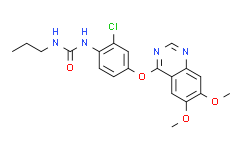| Description: |
KRN-633 is a potent VEGFR inhibitor with IC50s of 170, 160 and 125 nM for VEGFR1, VEGFR2 and VEGFR3, respectively. |
| In Vivo: |
KRN-633 inhibits tumor growth in several tumor xenograft models with diverse tissue origins, including lung, colon, and prostate, in athymic mice and rats. KRN-633 also causes the regression of some well-established tumors and those that have regrown after the cessation of treatment. KRN-633 is well tolerated and has no significant effects on body weight or the general health of the animals. Histologic analysis of tumor xenografts treated with KRN-633 reveals a reduction in the number of endothelial cells in non-necrotic areas and a decrease in vascular permeability[1]. |
| In Vitro: |
KRN-633 inhibits tyrosine phosphorylation of VEGFR-1, VEGFR2, c-Kit, and PDGFR-β (IC50=11.7, 1.16, 8.01, 130 nM) in human umbilical vein endothelial cells. KRN-633 also inhibits the VEGF-driven proliferation of HUVECs (IC50=14.9 nM). KRN-633 suppresses capillary tube formation of endothelial cells[1]. |
| Kinase Assay: |
Cell-free kinase assays are done to obtain IC50 values against a variety of recombinant receptor and non-RTKs. KRN-633 is tested from 0.3 nM to 10 μM. All assays are done in quadruplicate with 1 μM ATP[1]. |
| Cell Assay: |
A549, Ls174T, HT29, DU145, LNCap, and PC-3 cells cancer cells are cultured for 24 hours before adding KRN-633 (0.01 to 10 μM) or vehicle (0.1% DMSO in medium) and then grow for a further 96 hours. Cell viability is measured using WST-1 reagent. The percentage viability is determined relative to the untreated control[1]. |
| Animal Administration: |
Rats: Human tumor xenografts are established in the hind flank of athymic rats (BALB/cA, Jcl-nu). Rats are randomized into groups of five at the point when the tumors reach the average size indicated (162 to 657 mm3) and are then treated with KRN-633 or vehicle, either once (qd) or twice (bid) per day, at the dosages shown. The percentage of tumor growth inhibition compared with the vehicle-treated group is calculated on the day after the last treatment (day 14)[1]. Mice: The mice are randomized into groups of five at the point when the tumors reached the average sizes: 103 to 260 mm3 or 500 to 667 mm3. They are then treated with KRN-633 or vehicle, either once (qd) or twice (bid) per day, at the dosages of 10-100 mg/kg. The percentage of tumor growth inhibition (TGI) compared with the vehicle-treated group is calculated on the day after the last treatment[1]. |
| References: |
[1]. Nakamura K, et al. KRN633: A selective inhibitor of vascular endothelial growth factor receptor-2 tyrosine kinase that suppresses tumor angiogenesis and growth. Mol Cancer Ther. 2004 Dec;3(12):1639-49. |






















